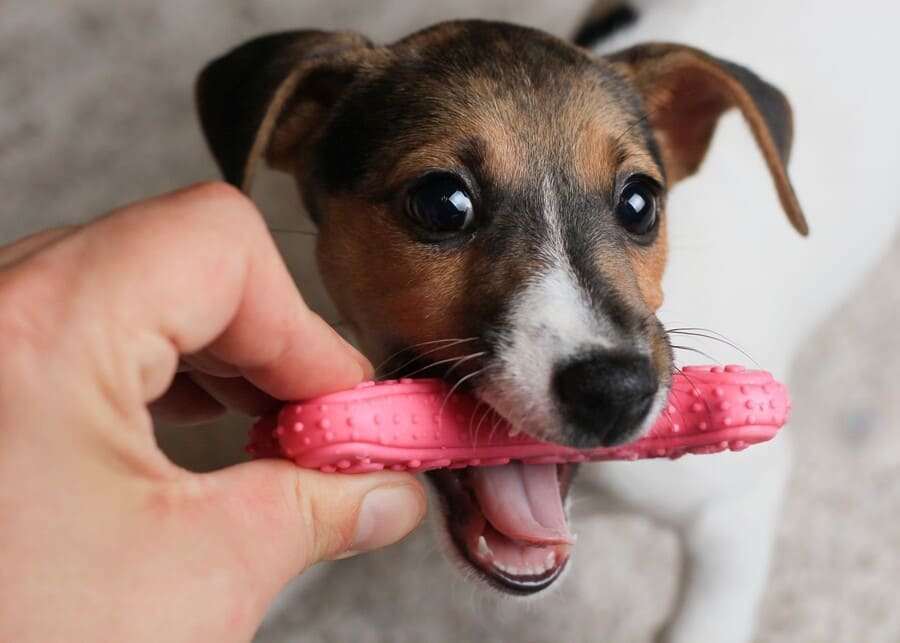Your customers’ puppies are chewing everything in sight. You need to stock toys that not only save their furniture but also build trust in your brand. What’s the solution?
The best teething toys for puppies are durable, size-appropriate, and made from non-toxic materials like natural rubber or BPA-free plastic. They should soothe sore gums, redirect destructive chewing, and be engaging enough to hold a puppy’s interest. Look for toys that can be frozen for extra relief.
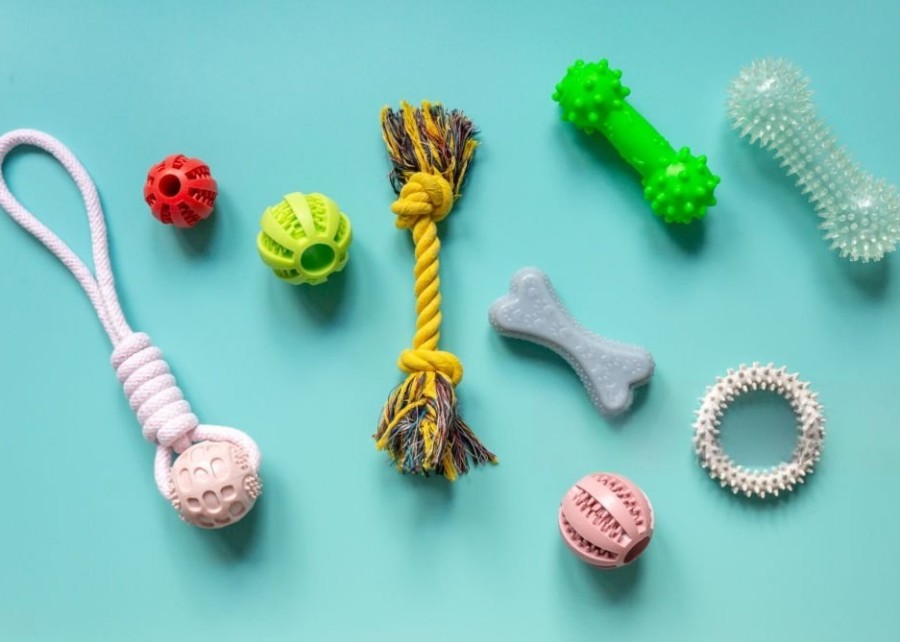
As a pet supply manufacturer for over a decade, I’ve seen countless brands succeed or fail based on their product choices. Choosing the right teething toys isn’t just about the puppy; it’s about building a foundation for your business. It’s about giving your customers answers and solutions they can trust. In this guide, I’ll walk you through the exact decision-making process I use with my top clients, from understanding the market timing to selecting packaging that sells. Let’s dive in and turn this common puppy problem into your next business opportunity.
What age do puppies start teething and need toys?
Are you missing the biggest sales window for puppy products? Many store owners stock up too late, missing the peak demand when puppies need relief the most.
Puppies typically start teething around 3-4 months old, as their baby teeth fall out and adult teeth emerge. The most intense chewing phase is usually between 4 and 6 months. This is the critical window when pet owners are actively searching for and buying teething toys.
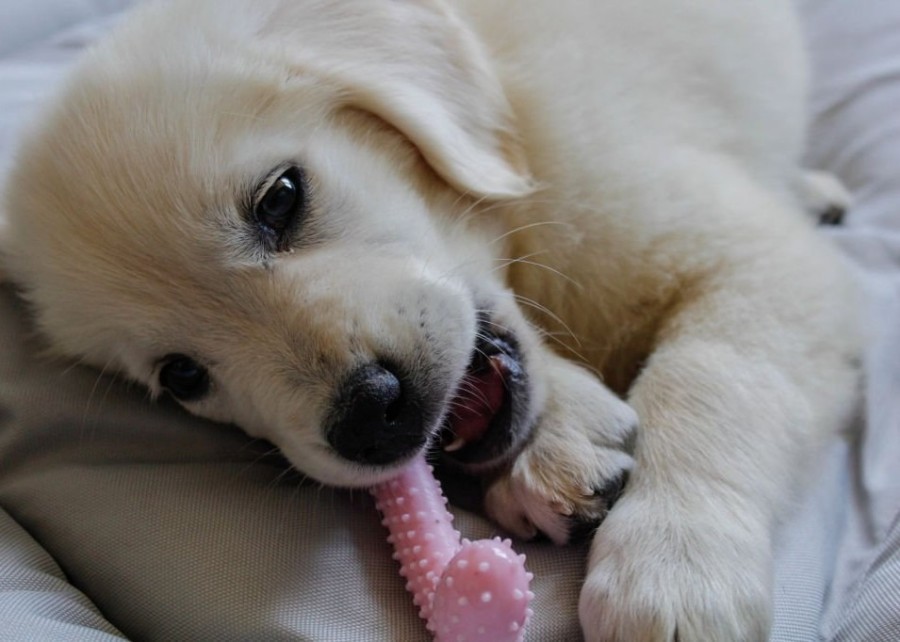
From a business perspective, this isn’t just a date on a calendar; it’s a strategic opportunity. Think of it as a predictable sales season. Here’s how I advise my clients to leverage this timeline:
Strategic Timing for Your Business
- Seasonal Stocking: Most puppies are born in the spring. This means you should be planning your inventory for teething toys in late spring and early summer to meet the peak demand. Waiting until fall means you’ve missed the majority of the market.
- Customer Acquisition: A pet owner with a teething puppy is a highly motivated buyer. If you can solve their immediate, urgent problem with a great teething toy, you’ve likely gained a loyal customer who will return for food, beds, and other supplies as their puppy grows.
- Cross-Selling Opportunities: This is the perfect moment to bundle products. When a customer buys a teething toy, they are also prime candidates for puppy training pads, chew deterrent sprays, and starter grooming kits. It’s your chance to increase the average transaction value.
Understanding this timeline transforms you from a simple retailer into a proactive advisor for new pet owners.
How do teething toys help puppies during the teething phase?
Your customers see a cute toy. But do they understand its real value? If you can’t explain the benefits, you’re just competing on price, not on expertise.
Teething toys provide a safe outlet for a puppy’s intense urge to chew. They soothe painful gums, help clean teeth, reduce destructive behavior on furniture, and teach appropriate chewing habits that last a lifetime. This makes them an essential tool for any new puppy owner.
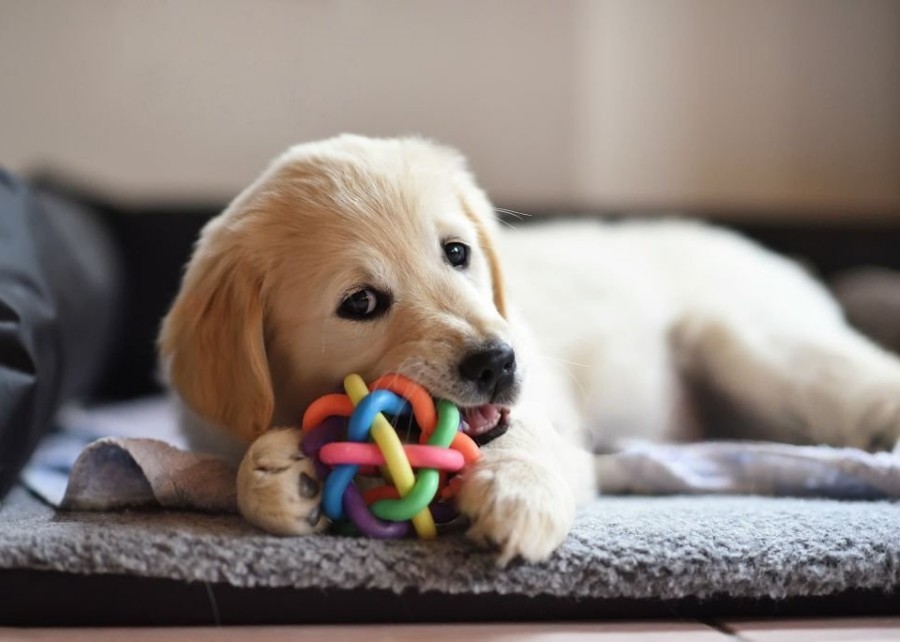
When I consult with brand owners, I tell them to think beyond the product itself and focus on the problems it solves. This is how you create value and justify your pricing. A teething toy isn’t just rubber or rope; it’s peace of mind for the owner and relief for the puppy.
Here’s how to frame the benefits for your customers:
The Core Functions of a Teething Toy
- Pain Relief: The pressure from chewing on a textured toy provides counter-pressure on a puppy’s gums. This feels good and alleviates the constant ache of new teeth pushing through. Toys that can be frozen are even better, as the cold temperature helps numb the sore gums, providing extra comfort.
- Behavioral Training: Every time a puppy chooses their toy over a shoe, it’s a training success. Teething toys are a critical tool for redirection. You are helping your customers teach their puppies what to chew, not just telling them what not to chew. This positive reinforcement is key to raising a well-behaved dog.
- Dental Health: While not a replacement for brushing, the surfaces of many teething toys help scrape away plaque as the puppy chews. This starts good dental hygiene habits early on.
By explaining these points, you show customers you understand their struggles and are providing a real solution, not just another dog toy.
What materials are safe for puppy teething toys?
A customer asks, "Is this toy safe for my puppy?" An unsure answer can kill a sale and damage your reputation. This question is about more than pet health; it’s about your business’s liability.
Safe puppy teething toys are made from durable, non-toxic materials. The best options are natural rubber, BPA-free TPR (Thermoplastic Rubber), and high-quality nylon. Always avoid materials that can easily break off into sharp pieces, like hard plastics, or contain harmful chemicals.
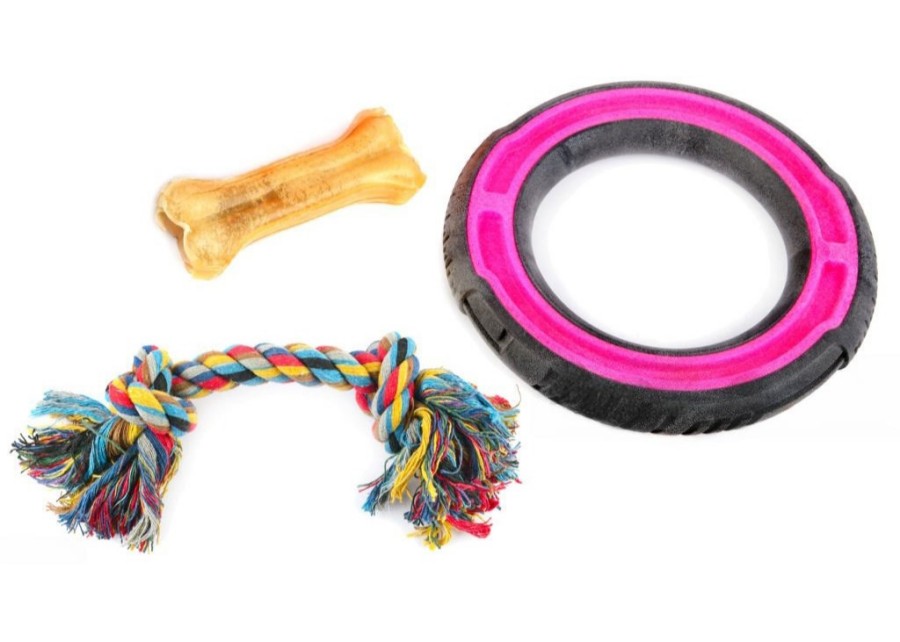
As a manufacturer, material safety1 is my number one priority. A product recall or a report of a sick pet can be devastating for a brand. That’s why we work so closely with clients to select materials that are not only safe but also compliant with international standards. This isn’t just a feature; it’s a non-negotiable part of your business’s risk management strategy.
Think about these factors when sourcing:
Material Analysis for Business Owners
| Material | Pros | Cons (for Business) | Best For |
|---|---|---|---|
| Natural Rubber | Durable, flexible, satisfying chew, often non-toxic. | Can have a strong smell initially; quality varies greatly. | All-around great choice for most puppies. Our most requested material. |
| TPR (Thermoplastic Rubber) | Lightweight, floats, can be molded into complex shapes. | Less durable than high-quality rubber for aggressive chewers. | Puzzle toys, floating toys, gentle chewers. |
| Nylon | Extremely durable, long-lasting. | Can be too hard for some puppies; risk of tooth damage if too aggressive. | Power chewers, but must be marketed with caution. |
| Rope (Cotton) | Good for cleaning teeth, interactive play. | Can be ingested if shredded, leading to blockages. A major liability risk. | Supervised play only. We advise clients to add clear warning labels. |
When you source from us, we provide documentation on material safety (like FDA or CE compliance). This isn’t just a piece of paper. It’s your proof of due diligence, protecting your business and giving you the confidence to tell your customers, "Yes, this is absolutely safe."
What size teething toys should I choose for different puppy breeds?
Have you ever had a customer return a toy because it was too big for their Chihuahua or destroyed in minutes by their Labrador puppy? The wrong size is a safety hazard and a business headache.
Choose a teething toy that is large enough that the puppy cannot swallow it, but small enough for them to comfortably carry and chew. For small breeds, look for lightweight, slender toys. For large breeds, prioritize larger, more durable toys that can’t become a choking hazard.
Offering a range of sizes isn’t just good service; it’s a smart business strategy that reduces returns and negative reviews. When I work with clients, we don’t just talk about one "perfect toy." We talk about creating a product line that serves the whole market. For example, a pet store chain client of ours, Judy from Germany, found that offering three distinct sizes of her best-selling chew toy reduced her "wrong size" returns by over 40%.
Here’s a simple framework to guide your purchasing and sales staff:
A Quick Sizing Guide for Your Store
-
Small Breeds (e.g., Yorkie, Pomeranian, Dachshund):
- Focus: Lightweight and easy to grip.
- Avoid: Heavy, bulky toys they can’t even lift.
- Your Pitch: "These are specially designed for small mouths, so your puppy can actually enjoy it."
-
Medium Breeds (e.g., Beagle, Cocker Spaniel, Corgi):
- Focus: Versatility. Can handle a bit more chew power.
- Avoid: Toys that are too small and could be swallowed.
- Your Pitch: "This is a great all-rounder for a growing puppy with developing jaw strength."
-
Large Breeds (e.g., Golden Retriever, German Shepherd, Labrador):
- Focus: Durability and size. Must be too large to fit entirely in their mouth.
- Avoid: Small or flimsy toys that can be destroyed and ingested.
- Your Pitch: "This toy is built tough for larger breeds to ensure it’s safe and will last."
By proactively guiding customers to the right size, you prevent problems before they start. This builds your authority and makes customers feel understood and well-cared for.
Rope toys vs rubber toys for teething puppies – which is better?
Customers often ask, "Should I get a rope toy or a rubber toy?" The wrong answer is to just pick one. The right answer is to understand their different jobs and how they fit into your market strategy.
For unsupervised teething, rubber toys are generally better and safer. They are more durable and less likely to be ingested. Rope toys are excellent for supervised, interactive play like tug-of-war and help clean teeth, but they can pose a serious risk if the puppy shreds and swallows the fibers.
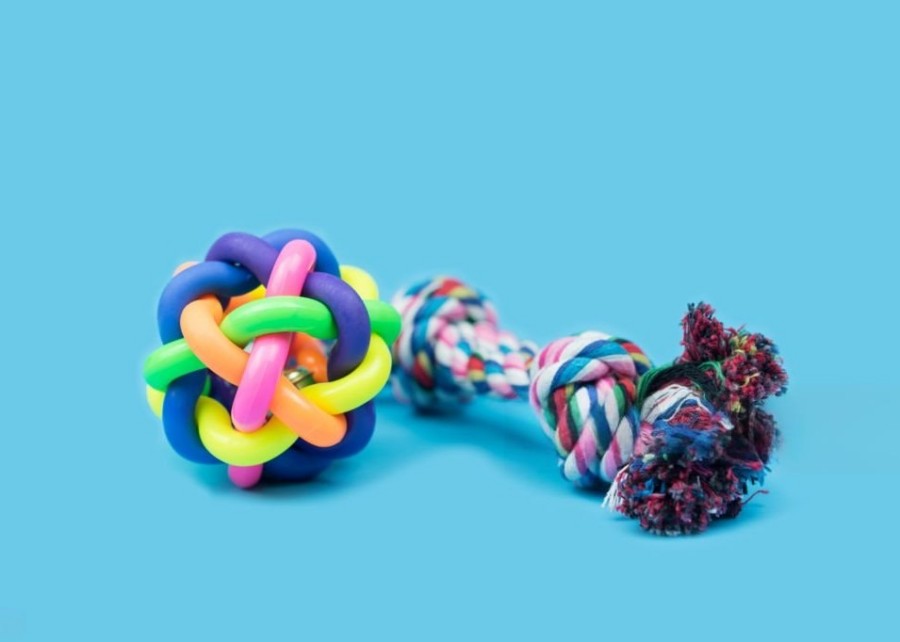
This isn’t a question of which toy is "better" in a vacuum. It’s a question of market positioning. As a consultant to pet brands, I advise them to think about their product mix not as a collection of items, but as a strategic portfolio. You need products that serve different needs and price points.
Here’s how to position these two popular categories:
A Strategic Look at Your Toy Selection
-
Rubber Toys: The Workhorse
- Market Position: The durable, practical, and safe choice. This is your mass-market appeal item.
- Key Selling Points: "Leave this with your puppy for safe, solo chew time." "Can be frozen to soothe sore gums." "Easy to clean and highly durable."
- Business Strategy: This should be your core offering. Offer various shapes and durability levels. This is the product you can sell in high volume.
-
Rope Toys: The Interactive Specialist
- Market Position: The "natural," eco-friendly, bonding-tool option. This can be positioned for a more engaged, premium customer.
- Key Selling Points: "The perfect toy for playing together and strengthening your bond." "Helps clean teeth naturally as they chew." Crucially, you must add: "For supervised play only."
- Business Strategy: Use rope toys to increase basket size. Bundle them with rubber toys in a "Puppy Starter Pack2." This shows you understand the different facets of puppy ownership: solo play and interactive play3.
By offering both and explaining the difference, you cater to a wider range of customers and establish yourself as a knowledgeable resource.
What are the best teething toys for puppies?
With so many options, what products should you actually stock? Your customers are overwhelmed. They need you to curate a selection of proven winners that solve real problems.
The best teething toys serve a specific purpose. Top categories include durable rubber chewers for safety, freezable toys for pain relief, and puzzle teethers for mental stimulation. The key is to offer a variety that addresses different needs, from gentle soothing to power chewing.
This is the core of your purchasing decision. Based on my experience manufacturing thousands of toy designs, the most successful brands don’t just sell a "toy." They sell a solution. This is where our ODM (Original Design Manufacturer) service shines.
A great example is my client, Garrett. He owns a successful pickleball paddle brand. He noticed his customers, who are passionate about their sport, often brought their bored dogs to matches. He came to us with an idea: a plush pickleball paddle toy for dogs. We worked with him to design a toy that mimicked his best-selling paddle but was built with durable, bite-resistant materials. It wasn’t just a toy; it was a brilliant brand extension that delighted his customers and opened a new revenue stream.
Here are the categories I recommend every pet supply business should carry:
My Recommended Teething Toy Portfolio
- The Durable Classic: A high-quality, non-toxic rubber toy4 (like a Kong-style or similar). It’s the go-to for most puppy owners. It’s reliable, can be stuffed with treats, and is extremely safe. This is your bestseller.
- The Soothing Chiller: A toy specifically designed to be frozen. These are often made of a softer rubber or TPR and provide immense relief for inflamed gums. Market this as a "must-have" for the peak teething phase.
- The Brain Builder: A puzzle or treat-dispensing teether. This engages a puppy’s mind, preventing boredom and the destructive behavior that comes with it. This positions you as a brand that cares about a dog’s mental well-being.
- The Gentle Gummer: A softer, more flexible toy for very young puppies or breeds with less powerful jaws. This shows you cater to the entire puppy lifecycle, from the earliest stages.
By offering a curated selection like this, you guide your customers to the right choice and prove your expertise.
How to test puppy teething toy quality before bulk ordering?
How can you be sure the products you’re ordering from overseas are actually high quality? Placing a large order without proper vetting is a huge financial risk. You need a trusted process.
Before placing a bulk order, always request production samples that are identical to the final product. Physically test them for durability, check for sharp edges or weak points, and verify the material safety certifications provided by the manufacturer. A good partner will be transparent with this process.
This is a step that many new importers overlook, and it’s often where things go wrong. At Preeminent, our reputation is built on trust and transparency. We don’t just send you a random sample; we have a rigorous quality assurance protocol because your success is our success. When you partner with us, you’re not just buying a product; you’re buying a promise of quality.
Here is the checklist I use with my team to ensure every product meets our standards, and it’s the same one you should use:
Your Pre-Order Quality Assurance Checklist
- Physical Stress Test:
- Does it hold up to pulling and twisting? Try to bend it in unnatural ways.
- Are there small parts that could be chewed off? (e.g., plastic eyes, flimsy appendages).
- Check all seams and connection points. These are the most common points of failure.
- Material Verification:
- Does the material feel like what was described? (e.g., heavy-duty rubber vs. lightweight TPR).
- Does it have a strong, chemical smell? This can be a red flag.
- Ask for the material safety data sheets (MSDS) or compliance certificates (FDA, CE). We provide these to all our clients.
- Design & Production Consistency:
- Does the sample exactly match the design specifications, including color (Pantone codes), size, and logo placement?
- For our ODM clients like Garrett, we ensure the mass-produced toy is an exact match to the approved prototype.
We also provide pre-shipment photos of your actual production run, packaging, and even the container being loaded. This complete transparency is how you can confidently order from overseas without worry.
What are the trending puppy teething toy designs in 2025?
Are you still selling the same basic bone shapes from five years ago? The market evolves. Staying on top of trends shows your brand is modern and in-touch with what today’s pet owners want.
In 2025, the top trends are multi-texture toys that combine different materials, toys made from sustainable and recycled materials, and interactive toys that connect with mobile apps. Pet owners are looking for products that are not only functional but also align with their values and offer enhanced engagement.
Staying ahead of trends is crucial for maintaining market share. As an OEM/ODM manufacturer, my R&D team is constantly exploring new materials, shapes, and concepts to bring to our clients. We don’t just react to the market; we help our partners lead it. Being based in the heart of manufacturing in China gives us a unique, real-time view of what’s new and what’s next.
Here are the key trends you should consider for your next product line:
Hot Trends to Watch
- Multi-Texture Surfaces: Think toys that combine smooth rubber, bumpy nubs, and soft ridges all in one. Puppies love variety, and these different textures keep them engaged for longer while providing a more complex gum-soothing experience.
- Sustainable and Eco-Friendly: The demand for products made from recycled or plant-based materials is growing rapidly. This is especially popular with Millennial and Gen Z pet owners. Offering an "eco-friendly" line can be a powerful market differentiator.
- "Calming" Toys: Toys that incorporate calming scents like lavender or can be filled with calming treats are gaining traction. This taps into the larger pet wellness trend, positioning your product as a tool for anxiety relief as well as teething.
By incorporating these trends, you’re not just selling a chew toy. You’re selling innovation, sustainability, and wellness. This is how you build a brand that resonates with the modern consumer.
What are common customer complaints about puppy teething toys?
Do you see customer complaints as a problem or an opportunity? Every negative review is a piece of market research that tells you exactly what product to develop or stock next.
The most common complaints are that the toy was destroyed too quickly ("not durable"), the puppy wasn’t interested in it ("boring"), or it was the wrong size ("choking hazard"). These complaints are direct feedback that can guide your product selection and marketing.
I tell my clients to embrace complaints. They are a roadmap to a better product and a stronger business. When a customer says a toy was too soft, they are asking you to sell them a more durable one. When they say their dog was bored, they are asking for a more engaging, interactive option.
Here’s how we turn common complaints into profitable business strategies:
Turning Complaints into Opportunities
- Complaint: "My puppy destroyed this in 5 minutes!"
- The Opportunity: Create or source a "Power Chewer" or "Indestructible" line. Market it specifically to owners of strong-jawed breeds. This allows you to command a higher price point for a premium, high-durability product.
- Complaint: "My puppy doesn’t care about this toy."
- The Opportunity: Develop a line of interactive or treat-dispensing toys. Create bundles with different shapes and textures. Market this as a "Boredom Buster Kit" to solve the problem of a picky puppy.
- Complaint: "This was way too small/big for my dog!"
- The Opportunity: Develop clear sizing guides on your packaging and website. Train your staff to be sizing consultants. This builds trust and reduces returns, as we saw with my client Judy. It establishes you as an expert who prevents problems rather than just selling products.
By listening to these complaints, you are getting free, direct instructions from the market on what to sell next. It’s the most valuable feedback you can get.
What packaging works best for puppy teething toys in retail?
Does your product’s packaging just hold the toy, or does it do the selling for you? On a crowded retail shelf, your packaging is your most important salesperson. It has seconds to grab attention.
The best packaging uses a clear window so customers can see the product’s texture and quality. It should feature a large, cute photo of a puppy, use minimal, benefit-driven text (e.g., "Soothes Gums," "Durable Chew"), and prominently display any safety certifications.
Packaging is one of the most underrated aspects of product development, but it can have a massive impact on sales. My client, Judy, who runs a chain of pet stores in Germany, saw a 23% increase in sales for one of her toy lines after we helped her redesign the packaging. We didn’t change the toy, just the box it came in.
When we design packaging for our private label clients, we focus on a three-step psychological process:
The 3 Layers of High-Converting Packaging
-
Attract Attention (The Glance): This is all about visual impact.
- Use a high-quality, emotionally appealing image: A happy, playful puppy is irresistible.
- Use bright, optimistic colors: Blues, greens, and oranges work well in the pet aisle.
- Clear Product Window: Let the quality of the toy speak for itself. Customers want to see what they’re buying.
-
Communicate Value (The Scan): The customer is now interested. What do they learn in 3-5 seconds?
- Benefit-focused headlines: Instead of "Rubber Toy," use "Soothing Teether for Sore Gums."
- Iconography: Use simple icons to show features like "Freezable," "Durable," "BPA-Free."
- Sizing Chart: A simple visual guide (e.g., Small, Medium, Large) on the back.
-
Build Trust (The Read): The customer is about to buy. Reassure them.
- Safety Logos: Prominently display "Non-Toxic" or any compliance logos (CE, etc.).
- Brand Story: A short sentence about your brand’s commitment to quality.
- Clear Instructions: "Supervised play recommended," "Inspect toy regularly."
Your packaging is your silent ambassador. Investing in good design is investing in sales.
Conclusion
Choosing the right puppy toys is a key business strategy. At Preeminent, we partner with brands like yours to turn these market insights into high-quality, best-selling products through our expert OEM/ODM and one-stop sourcing services. Ready to build your next hit product line? Contact us at to start the conversation.
-
Find out how to verify material safety for puppy toys to protect your business and customers. ↩
-
Check this resource for essential items to include in a Puppy Starter Pack for new pet owners. ↩
-
Find out how interactive play can enhance your puppy’s development and strengthen your bond. ↩
-
Find out why non-toxic rubber toys are essential for your puppy’s safety and health, ensuring a worry-free playtime. ↩

